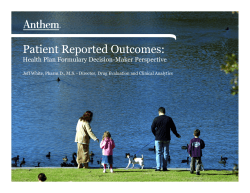
Deciphering the dose-response effect of Peanut Epicutaneous
Deciphering the dose-response effect of Peanut Epicutaneous ImmunoTherapy (EPIT) in peanut allergic subjects Dupont C.1,2, Agbotounou W.K. 3, Thébault C. 3, Ruban C.3, Martin L.3, Yang W.H.4, Sussman G.L. 5, Brown-Whitehorn T.F.6, Nadeau K.C. 7, Cheema A.S. 8, Leonard S.A. 9, Pongracic J.A. 10, Sauvage-Delebarre C. 11, Assa'ad A.H. 12, De Blay F.13, Bird J.A.14, Tilles S.A.15, Boralevi F.16, Bourrier T.17, Shreffler W.G. 18,Hébert J. 19, Green T.D. 20, Gerk van Wijk R. 21, Knulst A.C. 22, Kanny G. 23, Kowalski M.L. 24, Schneider L.C. 25, Benhamou P.-H. 3, Sampson H.A.26 Background: Peanut-specific EPIT proved safe and effective in a multicenter double-blind, placebo-controlled phase IIb trial (VIPES, AAAAI, 2015), using Viaskin® Peanut (VP) loaded with 50, 100 or 250 µg peanut protein (pp) or Viaskin® placebo. Subjects enrolled had an Eliciting Dose (ED) at their entry Double-Blind Placebo-Controlled Food Challenge (DBPCFC) ≤300 mg pp. The study was positive and the highest VP dose met its primary efficacy endpoint (proportion of responders at Month 12 with a pp ED during DBPCFC 10-fold greater than the pp ED at entry or reaching a post-treatment ED ≥1000 mg pp). To evaluate how robust was the desensitizing effect of VP against placebo in peanut-allergic subjects, a post-hoc analysis utilized a more stringent efficacy endpoint criterion. Method: Data from the VIPES study (221 subjects, 6-55 years including 113 children, 6-11) were re-analyzed based on a more stringent definition of efficacy: subjects with an ED at entry challenge ≤30 mg are responders to treatment only if they reached post-treatment ED ≥300 mg; subjects with entry challenge ED>30 mg are responders if they reached post-treatment ED ≥1000 mg. Results: Using this new efficacy criterion, a clear treatment dose-response effect was seen for the response rates in the whole population (placebo: 17.9%; VP50: 34.0% p=0.0787; VP100: 39.3% p=0.0206 and VP250: 48.2% p=0.0012 vs placebo) and especially in children (respectively 12.9%, 39.3%, 42.3%, 50.0%, p < 0.035 for the 3 doses). A dose-response effect was also observed in the challenge pp Cumulative Reactive Dose (CRD). In children, the median [Min, Max] CRD changes from baseline were: placebo: 0.0 [-400, 1000] mg, VP50: 135.0 [-430, 3300] mg; VP100: 114.5 [-100, 4300] mg and VP250: 400 [-300, 4442] mg. Analyzing children CRD with the Least Square Mean technique (covariates: baseline CRD value and country), the differences [95% CI] versus placebo were: VP50: 120.5 [9.25, 361.65] mg; VP100: 141.1 [17.61,411.43] mg and VP250: 390.4 [133.64, 947.24] mg. A dose effect was also seen for other secondary efficacy criteria at Month 12 including changes in IgE and IgG4 levels in the whole population and in children. Conclusion: A post-hoc analysis of VIPES study with a more stringent criterion further supported the efficacy of VP, especially VP250 to desensitize peanut-allergic subjects, particularly children: decreased placebo response, barely any impact on VP responses, clearer dose-response effect. Institute(s): 1 Hôpital Necker, Enfants Malades, Pediatrics-Gastroenterology, Paris, France, 2 Université ParisDescartes, Paris, France, 3 DBV Technologies, Bagneux, France, 4 University of Ottawa Medical School, Ottawa, Canada, 5 University of Toronto Faculty of Medicine, Toronto, Canada, 6 Children's Hospital of Philadelphia, Philadelphia, United States, 7 Stanford University School Medicine, Palo Alto, United States, 8 Alpha Medical Research, Mississauga, Canada, 9 Rady Children's Hospital, University of California, San Diego, United States, 10 Ann and Robert H. Lurie Children's Hospital of Chicago, Chicago, Uruguay, 11 Hôpital St Vincent de Paul, Lille, France, 12 Cincinnati Children's Hospital Medical Center, Cincinnati, United States, 13 Nouvel Hôpital Civil, Strasbourg, France, 14 University of Texas South Western Medical Center, Dallas, United States, 15 Northwest Asthma and Allergy Center, Seattle, United States, 16 Hôpital Pellegrin-Enfants, Bordeaux, France, 17 Hôpitaux pédiatriques de Nice CHU-Lenval, Nice, France, 18 Massachusetts General Hospital for Children, Boston, United States, 19 CRAAQ, Québec, Canada, 20 Children's Hospital of Pittsburgh of UPMC, Pittsburgh, United States, 21 Erasmus Medical Center, Rotterdam, Netherlands, 22 University Medical Center, Utrecht, Netherlands, 23 Hôpitaux de Brabois, Vandoeuvre-lès-Nancy, France, 24 Medical University of Lodz, Lodz, Poland, 25 Boston Children's Hospital, Boston, United States, 26 Icahn School of Medicine at Mont Sinai, New York, United States
© Copyright 2025















